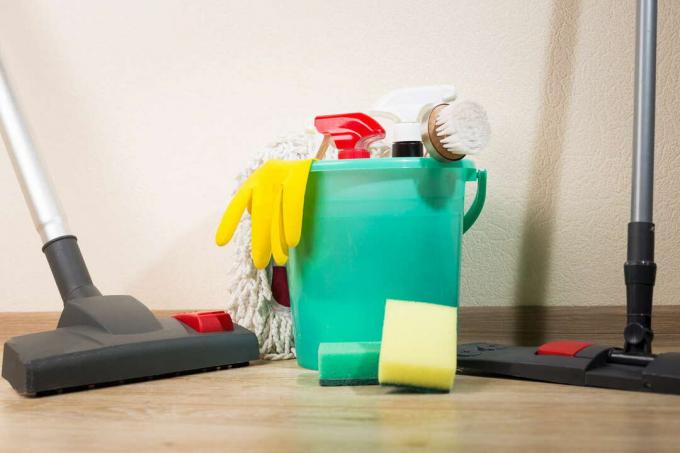Its name already reveals what the tobacco beetle eats best. We show you how to keep the little beetle away from your tobacco plants and how to fight them.

The tobacco beetle (Lasioderma serricorne) is one of the most important pests in tobacco production and also a Dreaded storage pest in foods such as flour, raisins, coffee beans, spices and many other products. But the tobacco beetle (as its name suggests) prefers to attack tobacco products.
contents
- Tobacco beetle: origin and profile
- Tobacco beetle: appearance and characteristics
- Recognize tobacco beetle infestation: the damage
- Prevent and control tobacco beetles
- Fight tobacco beetles naturally
Tobacco beetle: origin and profile
The tobacco beetle belongs to the rodent beetle family (Ptinidae). This beetle not only causes problems in the wild, but, as already mentioned, it is also a storage pest and can therefore really spoil our appetites. Basically, the tobacco beetle is pantropical. This means that the beetle originally comes from tropical and subtropical areas, where tobacco is also native. However, due to global trade, it is already spread all over the world. Fortunately, here in Central Europe the beetle cannot survive outdoors in winter.
Tobacco beetle: appearance and characteristics
Tobacco beetles are between 2 and 3 mm long, have a red to brownish color and a spherical, round head. You can see small hairs on the wings on the back, the antennae are toothed. When disturbed or frightened, the beetles tend to retract their legs and head and curl up motionless. The beetles are also able to fly and are particularly active at dusk. In contrast to the adult animals, the larvae are white in color and are also hairy - they look like grubs.

How fast the tobacco beetle develops and how long it lives depends heavily on the ambient temperature and how much food is available. Therefore, the duration of the life cycle varies - on average, development takes about 40 days to 90 days. At temperatures of 37 ° C, development takes only 26 days, but at 20 ° C it takes 120 days for the small beetles to develop fully.
A female can lay up to 100 eggs in the tobacco plants, and the larvae hatch after about a week. These go through at least four larval stages, sometimes even six within ten weeks. The larvae then pupate and rest for up to three weeks. The beetles then hatch from the pupae and development begins all over again.
The tobacco beetle and its offspring basically feed on tobacco products, but nuts, dried fruit, spices and many other stored foods are also on their menu. Ingredients such as nicotine or bitter substances do not affect this pest and can be used by the tobacco beetle. Adult specimens stop eating, they just drink. So adult animals are not the damaging stage.

Recognize tobacco beetle infestation: the damage
The tobacco beetle not only approaches tobacco plants, it can even destroy cigars. On the tobacco plants you can find traces of feeding on the leaves that come from the larvae.
To be sure whether you are dealing with a tobacco beetle, you can use special pheromone traps. Such traps are provided with female sexual attractants and therefore only attract male tobacco beetles. In the trap there is an adhesive surface to which the beetles stick and from which they can no longer free themselves. With the help of such a pheromone trap, an infestation can be determined and reproduction can ultimately be hindered, since the males are attracted by the trap. UV light traps can also be used to attract the tobacco beetle.

If the tobacco beetle is infested, not only is the tobacco in the cigars eaten, but the beetles and their larvae also eat the packaging. In addition to the round feeding holes and the feeding tunnels, they also leave excrement in the tobacco products and thus contaminate them. As soon as cigars or other foods are attacked by tobacco beetles and have been contaminated by their feces, these products can unfortunately no longer be used, let alone consumed. If the wrapper has been gnawed through on cigars, they no longer pull and are therefore useless.
Prevent and control tobacco beetles
When large farms are infested with tobacco beetles, the products are mostly fumigated with nitrogen and hydrogen or treated with high pressure and carbon dioxide. Since the tobacco beetle needs high temperatures for its development and survival, it is also very important to store the tobacco products at low temperatures. You should therefore ensure that it is stored in a dry and cool place and keep your pantries clean.
But what should you do now if your cigars have been nibbled on by tobacco beetles? First, you should check all of your cigars for the tiny holes the tobacco beetles nibble in. Every infected cigar must be destroyed immediately. To prevent further infestation with the beetle, it is best to put your cigars in a freezer bag and store them in the freezer for about a week. Then take the cigars out of the freezer and let them thaw again in this bag.
In the household, the use of insecticides is usually not necessary to fight the tobacco beetle, because you can get rid of these pests with a few simple methods. If the tobacco beetle has made its way into your pantry, it is particularly important to track down all infected food. You should therefore check every screw-cap jar and package in your kitchen for an infestation. Also, use this search for a thorough clean, removing any food scraps you may find. In principle, you can kill all stages of the tobacco beetle by freezing it, but the remains of the feces can be in Do not remove the food in this way - and insect infestation is certainly not essential appetizing.

As a preventive measure, you can take the following measures against the tobacco beetle:
- Keep storage rooms and cupboards clean
- Ensure cool and dry storage
- Pheromone traps can be used for control
Tips for fighting the tobacco beetle:
- Clean the infected area
- Carefully inspect the food and identify the source of the infestation
- Treat any food that may have been infected by freezing
Fight tobacco beetles naturally
A natural control method is the use of beneficial insects against tobacco beetles during cultivation. The tobacco beetle is caused by ground beetles (Carabidae), Black beetles (Tenebrionidae), Beetles (Cleridae) or also wasps (Chalcidoidea) eaten or parasitized. The use of such parasitoids is of little importance, however, as it ultimately cannot prevent contamination with tobacco beetles.
